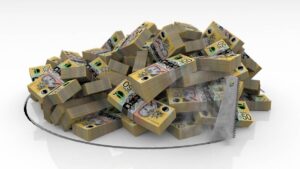Markets outlook: Five ETF trades for 2022, with Betashares chief economist David Bassanese

David Bassanese, chief economist at ETF provider Betashares.
As markets approach 2022, investors are coalescing around the idea that even if stocks continue their post-COVID rise, some increased volatility is expected.
Rate rises from the US Fed are officially on the cards. Then there’s the questions of Omicron and how that affects the reopening trade.
And it’s all happening in an environment where company earnings, while still growing, are starting to slow — at least in comparison to the unique post-COVID surge that lots of companies enjoyed.
To weigh it all up, Stockhead spoke this month with David Bassanese — chief economist at ETF provider Betashares.
Along with his appraisal of the outlook, Bassanese flagged some ETF trades that may complement investor portfolios amid the changing financial landscape.
Investment implications
With a number of competing forces to navigate, Bassanese said he still thinks equities can produce positive returns next year but “there’s probably a risk of a 5-10% dip as that Fed tightening cycle becomes a reality”.
“Equities never move in a smooth line but I think it’s going to be modest single digit returns on a one-year view, with earnings growth partly offset by the downward pressure on PE (price-to-earnings) valuations,” he said.
While earnings growth for many listed companies is still growing, Bassanese noted the pace of that growth has slowed — in some cases materially — from its post-COVID highs.
“The recovery is maturing and central banks are starting to take away stimulus, so they will be the two challenges for the market,” Bassanese said.
“It’s really a question of how the push-pull plays out of still-growing earnings, and that downward pressure on equity valuations due to higher interest rates — particularly given the Fed is now likely to be raising rates through next year.”
But while annualised inflation rates have held near multi-year highs through the second half of 2021, Bassanese said the market’s ability to digest those high CPI prints should be viewed as “good news” for the outlook.
“I think markets have held up remarkably well despite the big rise in inflation, particularly in the US,” he said.
While US Fed chair Jerome Powell recently dialled back the bank’s view that higher inflation would be ‘transitory’, Bassanese noted that central banks globally have largely held their ground in response to higher prices.
“I think the general consensus is still largely along those (transitory) lines. We’ll be anticipating an easing back of US inflation next year from very high levels this year,” Bassanese said.
At the same time, “that won’t stand in the way of the Fed. We think the central bank still won’t have any reasons not to start pushing rates above zero.”
If benchmark cash rates rise, it may also prompt a recalibration in global bond markets with some upward pressure on bond yields, Bassanese said.
In that environment, the ‘growth vs value’ debate will remain in play heading into next year.
“Tech and consumer discretionary (e.g. ecommerce) stocks against sectors such as energy and financials will be a key thematic,” Bassanese said.
“Rising bond yields tend to favour financials over tech stocks. It may not favour energy as much and we could see energy prices level off in a rising rates environment.’
ETF trades
Turning to ETF trades on the Betashares platform, Bassanese said one way to position for higher yields is through the BNKS ETF.
The vehicle provides investors broad exposure to a portfolio of global banks, with US giants JP Morgan Chase, Bank of America and Wells Fargo making up the three largest weightings.
“Global banks tends to outperform when bond yields are rising, while things that may come under pressure include those tech exposures that have outperformed since the pandemic began,” Bassanese said.
“We’ve seen that a bit already on the Nasdaq, where outside of the top five or six major companies many high-PE US tech companies have already corrected signficantly,” he added.
Along with growth vs value, another framework worth using is the cyclical vs defensive construct — stocks that stand to benefit from the reopening trade compared with defensive companies which find demand when risk sentiment falls.
A good example of that this week was the ASX 200 Health index, where healthcare stocks that generate consistent earnings streams found demand amid broader jitters on global markets.
On that front, the Betashares DRUG ETF provides exposure to a suite of global healthcare stocks that often outperform when the market falls, Bassanese said.
“Another one that usually does well in that environment is the Betashares QLTY ETF, which is comprised of companies that screen for specific ‘quality’ metrics such as low debt and above-average return-on-equity (ROE),” he said.
“Quality tends to perform in most parts of cycle, apart from early recovery from a recession tends. And it tends to outperform when equities suffer a pullback.”
“So the first part of last year when markets started to recover is when quality underperformed. But heading into 2022 it may help to anchor a diversified portfolio,” he said.
Lastly, Bassanese suggested that investors could position for a macro shift where central banks globally are raising rates and tightening policy at different speed.
The two-paced nature of the post-COVID recovery means policy responses are likely to flow through to changes in currency markets.
“For example, the if US raises rates before other major economies like Europe and Japan, that could result in ongoing strength in the US dollar,” Bassanese said.
Such a backdrop may help provide an export (and economic) boost to those mature economies with comparatively weaker currencies.
In that environment, Bassanese recommended two Betashares ETFs — HEUR and HJPN — funds that offer exposure to some of the largest companies in Europe and Japan, where returns are currency-adjusted back into Australian dollars.
UNLOCK INSIGHTS
Discover the untold stories of emerging ASX stocks.
Daily news and expert analysis, it's free to subscribe.
By proceeding, you confirm you understand that we handle personal information in accordance with our Privacy Policy.








